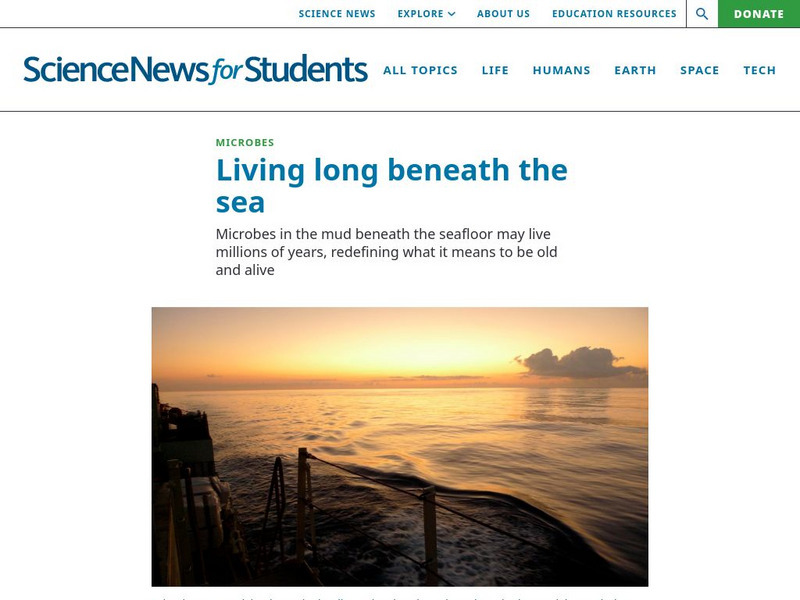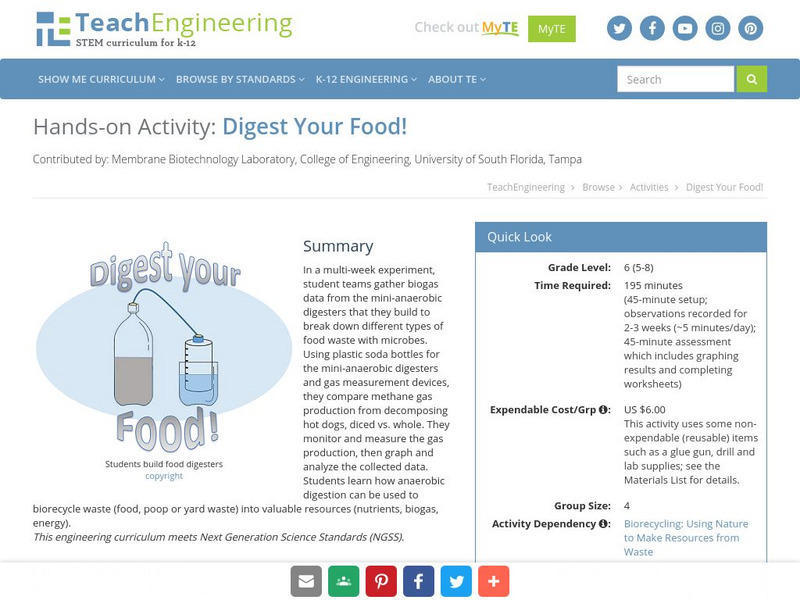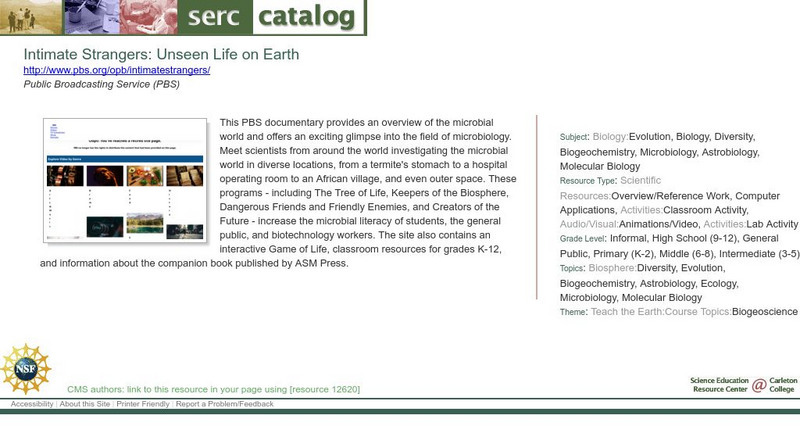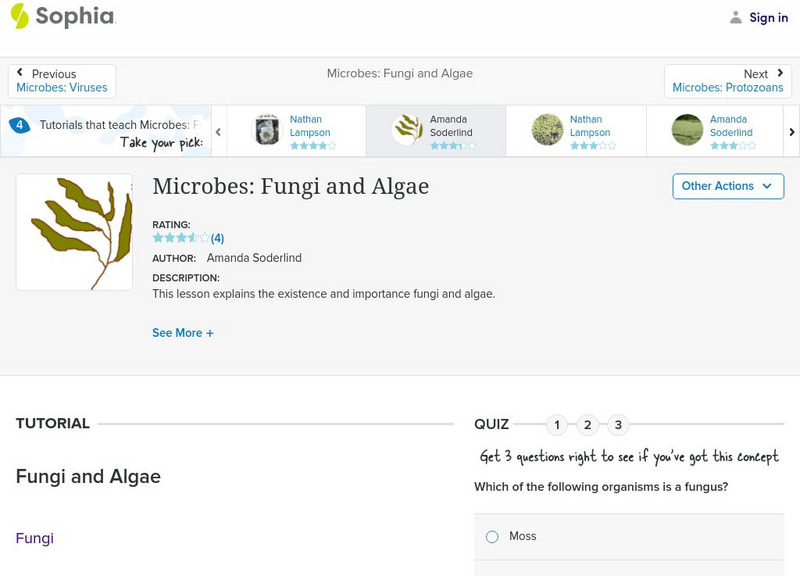Curated OER
Microbes and Health
Sixth graders become acquainted with the concept of how microorganisms cause disease. They role play that some class members have exhibited some alarming symptoms. Groups must determine which disease the symptoms are pointing to.
Curated OER
An Ancient Disease: Who Am I?
Sixth graders research the positive and negative aspects of microorganisms noting the challenges faced by early scientists. They investigate the history of a disease of their choosing and write a summary of their findings.
Michigan State University
Michigan State University: Digital Learning Center for Microbial Ecology: Microbe Zoo: Poo Corner
A light-hearted and informative section about the role of microorganisms in decomposing human waste. It has a colorful, clickable graphic aiding in navigation of the site. Fun and informative.
TED Talks
Ted: Ted Ed: You Are Your Microbes
From the microbes in our stomachs to the ones on our teeth, we are homes to millions of unique and diverse communities which help our bodies function. The following learning module emphasizes the importance of understanding the many...
Science Buddies
Science Buddies: Effects of Food Preservatives on the Growth of Microorganisms
The problem of protecting food from spoilage has been with us since prehistoric times. The solutions to this problem have changed with advances in technology and knowledge about what causes food to spoil. This project uses liquid...
Science Education Resource Center at Carleton College
Serc: Investigating Microbes in a Nature Center
In this Nature Center activity, students will identify microbes found in the pond and creek in the Eden Valley-Watkins Nature Center. They will collect samples using a Petri dish.
BioEd Online
Bio Ed Online: The Science of Microbes: Comparing Sizes of Microorganisms
Middle schoolers create models of microbes to scale, and compare their sizes and shapes. A 'Microbe Scaling Chart' is provided. The lesson and a set of PowerPoint slides can be downloaded. An accompanying instructional video is 6 min. 39...
Society for Science and the Public
Science News for Students: Beneath the Sea
What does it mean to be alive? Scientists are now revisiting this question as they discover previously unknown microorganisms at the bottom of the ocean.
TeachEngineering
Teach Engineering: Biological Processes: Putting Microbes to Work
Students learn the fundamentals of using microbes to treat wastewater. They discover how wastewater is generated and its primary constituents. Microbial metabolism, enzymes and bioreactors are explored to fully understand the primary...
Science Education Resource Center at Carleton College
Serc: Microbial Life: Microbial Life in Extreme Environments
Here is comprehensive information about microbes living in extreme conditions. Explore the definition of extremophile, what makes an extreme environment, and types of extreme environments. Site includes pictures, information and other...
Centers for Disease Control and Prevention
Centers for Disease Control: Listeria
Answers to the most frequently asked questions on Listeriosis - symptoms, causes, targets, treatment and more. Includes technical and general terms.
TeachEngineering
Teach Engineering: Digest Your Food!
In a multi-week experiment, student teams gather biogas data from the mini-anaerobic digesters that they build to break down different types of food waste with microbes. They compare methane gas production from decomposing hot dogs,...
Lawrence Berkeley National Laboratory
Berkeley Lab: Did You Ever Wonder? Best Bugs for Cleaning Up Toxic Waste?
Students explore bioremediation. The article discusses how to use infrared synchrotron light to study the biological response of living microbes to contaminants. The resource consists of pictures, quotes, and links to additional resources.
Science Education Resource Center at Carleton College
Serc: Intimate Strangers: Unseen Life on Earth
This PBS documentary provides an overview of the microbial world and offers an exciting glimpse into the field of microbiology. Meet scientists from around the world investigating the microbial world in diverse locations, from a...
Science Education Resource Center at Carleton College
Serc: Bio Media Associates: Learning Programs for Biology
This site provides photographs, animations, essays, teaching resources, multimedia, and other information about biological systems and organisms. It features a monthly contest and quiz in which students and teachers identify a mystery...
Science Education Resource Center at Carleton College
Serc: Biofilms: Online Manual
This on-line collection of exercises can be conducted to illustrate the formation and properties of microbial biofilms. Activities include: A Biofilm Primer, An Interesting Paradox, Build a Biofilm Reactor, Bring 'em Back Alive, Buccal...
TED Talks
Ted: Ted Ed: The Microbial Jungles All Over the Place (And You)
As we walk through our daily environments, we're surrounded by exotic creatures that are too small to see with the naked eye. We usually imagine these microscopic organisms, or microbes, as asocial cells that float around by themselves....
Other
Pittsburgh Post Gazette: Listeria Prompts Usda Warning
Article describing how listeria cases and outbreaks prompted the USDA to issue warning labels on certain foods. Foods highlighted include hot dogs and lunch meats. Gives details on cases and prevention steps.
Other
Composting Practices (Pdf) [Pdf]
This publication explains the agricultural and environmental benefits of composting household waste. It explains the difference between hot and cool composting systems. It also documents research indicating turfgrass benefits from humus...
PBS
Pbs Teachers: Mysteries of the Universe
Consider the issues surrounding the world of space exploration including the new fields of archaeoastronomy and astrobiology. Investigate zero gravity, the Big Bang theory, life in space and how sound travels in a vacuum.
Morning Earth
Biosphere Community: Microbes: Germs
Scholars explore the science topic of germs. The tutorial consists of definitions, examples, and pictures about germ theory.
University of Guelph
Introduction to Invertebrate Biodiversity: Fungi
Find out more about fungi when you check out this comprehensive site. This resource provides an introduction and information on morphology, reproduction and the importance of fungi. Don't miss out on this fascinating source.
Oak Ridge National Laboratory
Ornl: Genomics and Its Impact on Science
This site from the Human Genome Project for the Oak Ridge National Laboratory is the index page for chapters which include an introduction to genes, the mapping sequence of genes, and the impact and future of the Human Genome Project.
Sophia Learning
Sophia: Microbes: Fungi and Algae: Lesson 1
This lesson explains the existence and importance fungi and algae. It is 1 of 4 in the series titled "Microbes: Fungi and Algae."




















![Composting Practices (Pdf) [Pdf] Handout Composting Practices (Pdf) [Pdf] Handout](https://d15y2dacu3jp90.cloudfront.net/images/attachment_defaults/resource/large/FPO-knovation.png)




